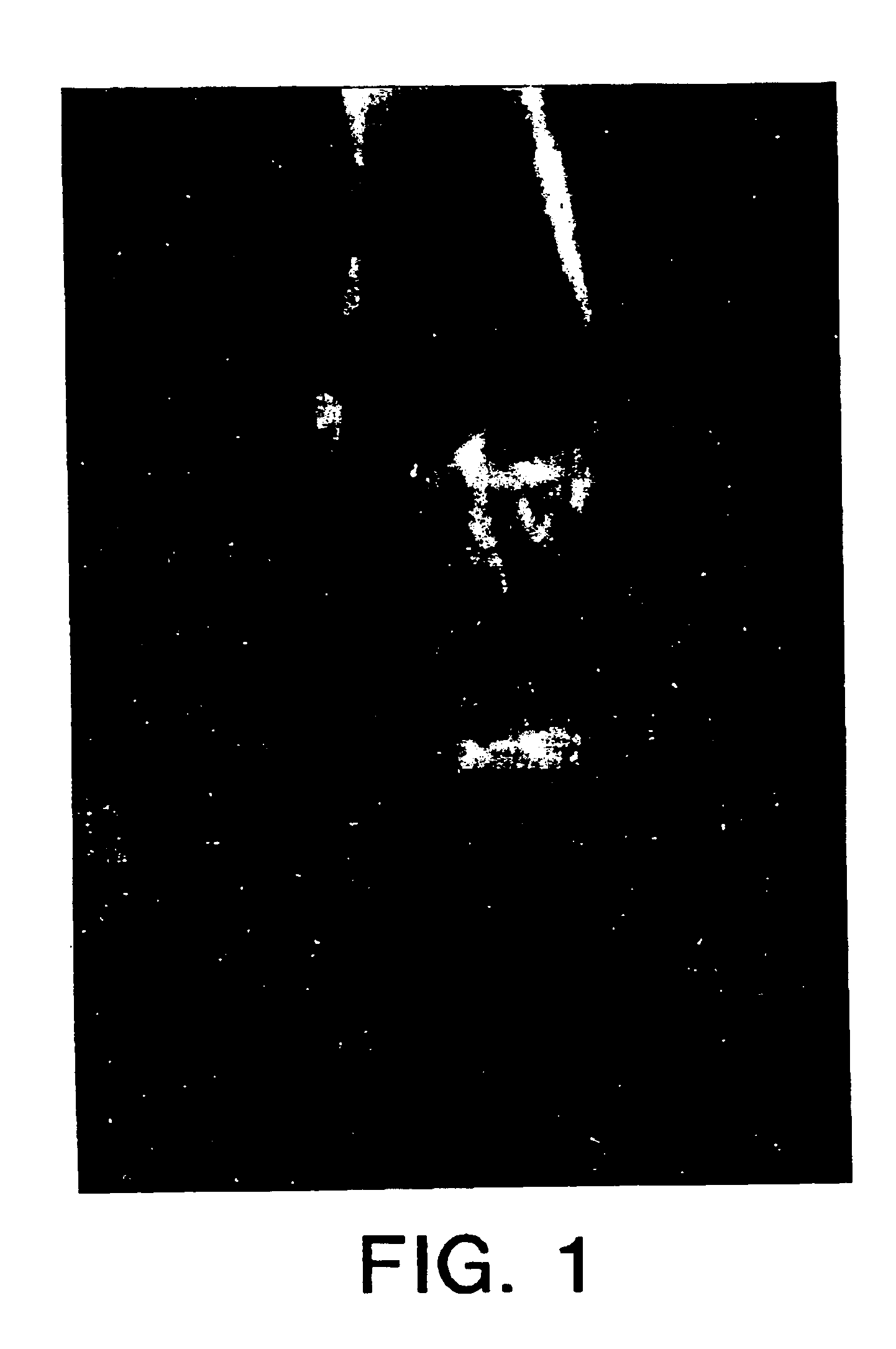Radio-opaque polymeric biomaterials
- Summary
- Abstract
- Description
- Claims
- Application Information
AI Technical Summary
Benefits of technology
Problems solved by technology
Method used
Image
Examples
example 1
Synthesis of DITE
DITE (3-(3-iodo-4-hydroxyphenyl)propanoic acid-tyrosine ethyl ester) is a bisphenol carrying one iodine atom at position 3 of one of the two phenolic rings. This bifunctional molecule can be polymerized as illustrated in the subsequent Examples. This Example describes the method used to introduce the iodine atom in the aromatic ring (4-hydroxyphenyl)propionic acid, and the coupling of this iodinated derivative with tyrosine ethyl ester in order to obtain DITE.
Preparation of solution (a): to a 250 mL Erlenmeyer flask were added 100 mL of distilled water, 24 g of potassium iodide, and 25 g of iodine. The mixture was stirred overnight until all solids dissolved.
Preparation of solution (b): 16.6 g (0.1 mole) of DAT were placed in a 3-necked Morton-type round bottom flask, equipped with an overhead mixer and a 125 mL addition funnel. 140 mL of 40% trimethylamine solution in water were added, and the mixture was stirred until a clear solution was obtained.
Solution (a) was...
example 2
Poly(DITE Carbonate) by Solution Polymerization
This material is the polycarbonate obtained by reacting DITE, obtained in Example 1, and phosgene.
Polymerization of DITE with Phosgene
A 250 mL 3-necked flask equipped with a mechanical stirrer and an addition funnel was purged with nitrogen for 15 minutes. 7.62 g (15.8 moles) of DITE were added to the flask followed by 39 mL methylene chloride and 4.79 mL distilled pyridine. The mixture was stirred until a clear solution was obtained, then it was chilled in an ice-water bath. 9.8 mL of 20% phosgene solution in toluene were placed in the addition funnel and added to the reaction flask at a constant rate so that the entire addition was complete in 1.5 hours. The mixture was stirred for one more hour, then it was diluted with 200 mL THF, and the polymer was precipitated by dropping the solution in a large excess of ether through a filter funnel. The precipitated polymer was washed with ether, transferred to an evaporating dish, and dried o...
example 3
Poly(DITE-co-5% PEG1K Carbonate) by Solution Polymerization
In this Example, 5 mole % of PEG1000 was copolymerized with DITE through phosgenation by means of a solution polymerization technique similar to that described in Example 2. The resulting material is a random polycarbonate.
Copolymerization of DITE and PEG1000
A 100 mL 3-necked round bottomed flask equipped with an addition funnel and an overhead stirrer was purged with nitrogen for 30 minutes. The flask was charged with 5 g (10.33 mmoles) of DITE, and 0.545 g (0.55 mmoles) of PEG1000, then 23 mL of methylene chloride and 3.3 mL of pyridine were added, and the mixture was stirred until a colorless, clear solution resulted. The flask was cooled in an ice-water bath, and 6.4 mL of 20% phosgene solution in toluene were added dropwise over a period of 90 minutes from the addition funnel. The mixture was diluted with 90 mL of THE, and stirred for one more hour. The product was isolated by precipitation in 800 mL of ethyl ether, and...
PUM
| Property | Measurement | Unit |
|---|---|---|
| Composition | aaaaa | aaaaa |
| Acidity | aaaaa | aaaaa |
| Biocompatibility | aaaaa | aaaaa |
Abstract
Description
Claims
Application Information
 Login to View More
Login to View More - R&D
- Intellectual Property
- Life Sciences
- Materials
- Tech Scout
- Unparalleled Data Quality
- Higher Quality Content
- 60% Fewer Hallucinations
Browse by: Latest US Patents, China's latest patents, Technical Efficacy Thesaurus, Application Domain, Technology Topic, Popular Technical Reports.
© 2025 PatSnap. All rights reserved.Legal|Privacy policy|Modern Slavery Act Transparency Statement|Sitemap|About US| Contact US: help@patsnap.com



